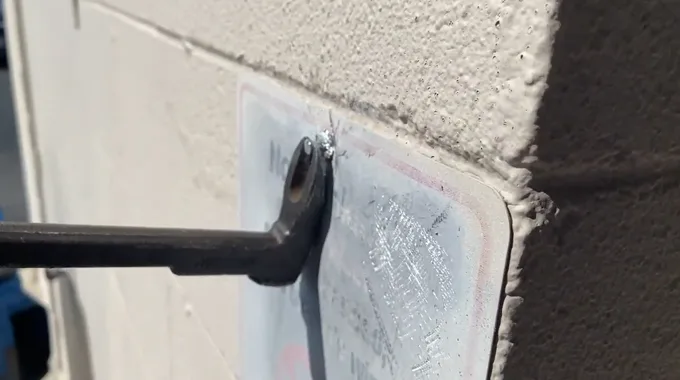Last Updated on January 20, 2023
Removing hammer drive concrete anchors is a challenging process requiring specialized tools and careful preparation. These fasteners, consisting of a head, shank, and expansion clip, are embedded in walls or surfaces with the aim of securing objects firmly in place.
Removing these items takes patience and expertise for successful completion without compromising safety standards. We’ll discuss essential tools and equipment, the importance of proper preparation, as well as step-by-step removal guidelines.
Discover how to execute standard practices so that your next project is a success. Learn everything you need to know about safely removing hammer drive concrete anchors.
Required Tools for Each Type of Hammer Drive Concrete Anchor Removal

Chisel or Punch
A chisel or punch is an essential tool to remove concrete anchors driven by hammers. These tools are used to cut away any excess material left behind by the anchor, allowing for easy extraction of the anchor itself.
When selecting a chisel or punch, it is important to choose one that is made from high-quality steel so that it can withstand any wear and tear during the removal process. Additionally, a larger chisel or punch will provide more control and leverage over the anchor as it is being removed.
Hammer or Mallet
A hammer or mallet can be used to dislodge hammer-drive concrete anchors. This tool should have a good weight distribution so enough force can be applied when extracting the anchor.
A rubber mallet can also be used for added cushioning and protection when striking against more complex surfaces such as concrete or brick.
Since different types of materials require different levels of force and precision, it is essential to choose a tool with adjustable power settings to work carefully on more delicate tasks while still applying enough pressure when necessary.
Claw Hammer or Flathead Screwdriver
It is sometimes possible to remove Hammer Drive Concrete Anchors using a claw hammer or flathead screwdriver. If using either of these tools, ensure that they are appropriately sized for the job at hand. Additionally, when using either tool, go slowly and evenly so as not to cause any further damage to the surrounding area.
Socket Wrench Set
A socket wrench set is required to remove the hammer drive and concrete anchor. This set consists of a handle and several interchangeable sockets that fit onto the handle and are designed to fit around a screw or bolt head.
These wrenches come in both metric and imperial sizes to accommodate different types of anchors. Socket wrenches provide the necessary torque to loosen and tighten the anchors without damaging them, making removal more accessible and efficient.
Combination Wrench Set
A combination wrench set is necessary for the safe removal of hammer drive concrete anchors. This type of wrench has an adjustable jaw that can fit various sizes of fasteners, making it ideal for tightening or loosening them without damaging them during the process.
The combination wrench also includes an open-ended head for larger fastening applications such as nuts or bolts, making it even more versatile and capable of handling various tasks.
It’s essential to purchase a quality combination wrench set made from hardened steel components that will last through multiple projects without breaking down or becoming worn out prematurely.
Allen Key Set
An Allen key set is an essential tool for disengaging hammer drive concrete anchors. The keys are designed to fit into small hexagonal holes on screws and bolts, providing additional leverage while loosening or tightening them without damaging them.
Allen keys come in various lengths, making them suitable for tackling most types of anchors easily while providing maximum precision when working on tight spaces where regular wrenches cannot reach easily.
Quality sets should be purchased with hardened steel components that resist wearing over time due to everyday use during project completion.
Drill Bit
A drill bit is often used when removing hammer drive concrete anchors because it produces quick results.
The drill bit should be chosen according to the size of the anchor being removed and its material composition. Stainless steel bits are ideal for working with stainless steel fasteners, while carbide bits are better suited for more complex materials such as cast iron or masonry materials.
When selecting a drill bit, it’s essential to purchase one built from high-quality materials such as cobalt alloy, which will resist corrosion over time while maintaining sharpness even after repeated uses during project completion.
Rotary Hammer Drill
Rotary hammer drills are sometimes used to remove hammer drive concrete anchors, as they can drill faster than traditional cordless drills while remaining lightweight.
It is essential to have experience with a rotary hammer drill before attempting to use one, as the process involves greater force than everyday drilling applications.
Proper technique must be followed at all times when using a rotary hammer drill to avoid damage to surrounding structures like walls or pipes.
Step-by-Step Guide on How to Remove Hammer Drive Concrete Anchors
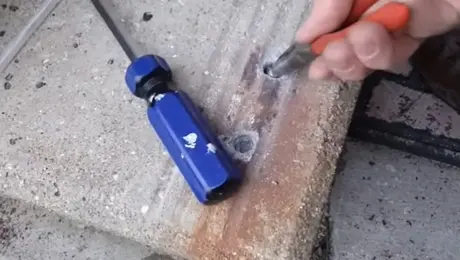
Step A. Determine the Type of Hammer Drive Concrete Anchor Being Used
This first step is incredibly important as it will determine what tools and equipment are necessary for removing the anchor. The most common kind of hammer drive concrete anchors are sleeve anchors, which have an externally threaded cylinder with a nut and washer attached to the end.
Other types include drop-in anchors and wedge anchors. Each type requires different tools, so it is important to identify the type used before beginning the removal process.
Step B. Select and Gather the Proper Tools and Equipment Necessary for Removing the Anchor
For different types of hammer drive concrete anchors, different tools may be needed to remove them successfully.
Most commonly, a drill or impact driver, chisel or hammer, socket set, and possibly even a hacksaw will be necessary to complete this task safely and efficiently.
It is important to select quality tools that can handle tough jobs like these to ensure the successful completion of this project.
Step C. Prepare the Area for Working on the Anchor
Before starting to remove a hammer drive concrete anchor, it is important to prepare the area and make sure that you have all of the necessary tools and equipment.
First, you need to clear the work area by removing any objects that could interfere with or block access to the anchor. Then, you need to ensure that the site is free from dust and dirt so that your tools will be able to slide across the surface smoothly without damaging it.
You may also want to wear safety glasses and gloves while working in case pieces of trash fly off during the process.
Step D. Start Drilling Into the Head of the Hammer Drive Concrete Anchors
After preparing your work area, you can begin creating drill holes in the heads of hammer drive concrete anchors. You’ll need a masonry drill bit slightly larger than your anchor’s diameter and an electric drill or screwdriver for this step.
Begin by slowly drilling into the head of your concrete anchors until you reach a depth of about ½-inch into its surface. Be sure not to use too much force, as this could cause damage to both your tool and wall.
Step E. Separate the Unwanted Section from the Rest of the Wall Using a Cold Chisel or Hammer Combo
Once you have drilled far enough into your anchor, it’s time to separate it from the rest of its surrounding structure using either a hammer combo or a cold chisel tool attachment.
This will help break apart any glue or mortar around your anchor without causing any further damage. Take caution when using these tools since they can be quite powerful.
If you’re uncomfortable using them at full strength, start out with lower power settings before increasing them gradually until your application is successful.
Step F. Brush Away After Unwanted Section Has Been Removed
After successfully separating your unwanted section from its surrounding structure, take a brush and sweep away any loose dust left behind by your tools so everything appears neat and tidy once again.
This is an essential step since leaving specks of dust behind can potentially attract vermin or become a hazard for anyone in proximity to where it was removed from initially.
Finish up by disposing of any materials safely in accordance with local regulations before continuing with whatever other projects are on your agenda.
Read this: Where Do I Store My Sledgehammer?
How Do You Remove Concrete Wall Anchors?
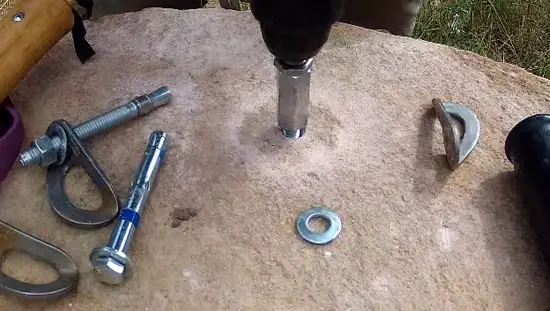
To remove wall anchors from concrete walls, start by tapping them gently with a hammer to loosen them up. If they don’t come loose easily, then you may need to drill out the plaster around them with a masonry bit in order to access them more easily.
Then use pliers or locking pliers to pull out each anchor one at a time until all are removed. Finally, clean away any leftover remnants from drilling and patch up any holes left behind before replacing them with new anchors if necessary.
How Do You Remove Anchoring Adhesive?
Removing anchoring adhesive requires different methods depending on its type and application surface. For example, if it is an acrylic-based adhesive used on non-porous surfaces like glass or metal, then it can be removed using acetone or paint thinner and some elbow grease.
If it is an epoxy adhesive used on porous surfaces like wood or cement, then it will require mechanical chipping off first, followed by chemical solvents such as mineral spirits or turpentine for effective removal.
How Do You Remove Concrete Wedge Anchors?
Concrete wedge anchors are removed using either standard hand tools, such as wrenches and hammers, or specialized tools, such as wedges, flat bars, and bolt cutters.
The nuts located at either end of the anchor bolts are unscrewed using appropriate tools. Each anchor is levered out individually with additional force if required. Safety gear should be worn whenever working with heavy metal components.
How Do You Remove an Anchored Object?
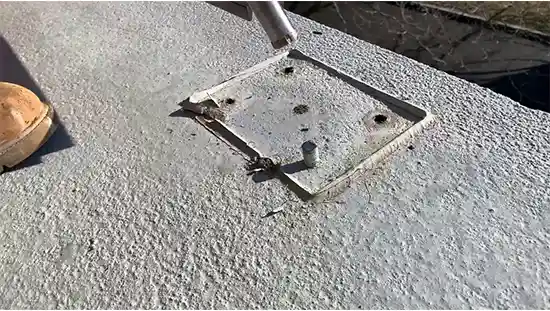
If trying to remove an object from its anchored position, there are often several options available which will vary depending on the material composition. Start by cutting off any visible screws/bolts holding the object in place.
Chisel away at mortar/concrete where anchoring points have been set into the surface area of the structure. Once all support has been broken free, lift off (use assistance if necessary) for complete removal.
Are Drop-In Anchors Removable?
Drop-in anchors are removable but typically require specialized tools in order to do so. To remove a drop-in anchor, the head of the anchor needs to be exposed first. This is typically achieved by drilling out the material that was set over the anchor when it was first installed.
Once the head of the drop-in anchor is exposed, an extraction tool can be used to remove it from the concrete or masonry material. The extraction tool works by grabbing onto the lip of the drop-in anchor and pulling it out while simultaneously unscrewing its body from within.
Is a Sleeve Anchor Permanent?
A sleeve anchor is generally considered a permanent solution for attaching something to concrete or masonry materials because once it has been inserted, it cannot be removed without breaking it apart into multiple pieces with specialized tools.
To install a sleeve anchor, you insert a setting tool into its body which expands it outward and sets it firmly in place.
The installation of a sleeve anchor is permanent unless the right tools are at hand. With an electric hammer drill fitted with specialized bits such as a carbide-tipped hole saw and grinder wheel bit, one can easily remove it in no time.
You Can Also Read: Does Drywall Anchor Holes can be filled with any household items?
How Do You Remove Chemical Anchor Bolts from Concrete?
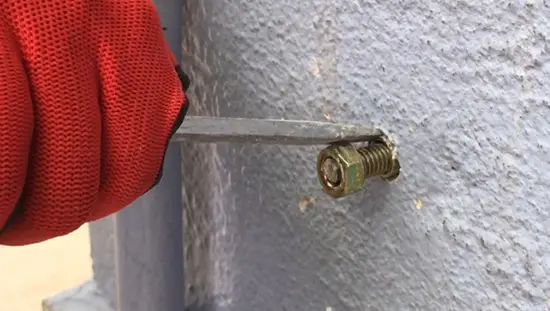
Chemical anchor bolts can usually easily be removed from concrete by using an ordinary wrench or ratchet set and socket system. First, you must identify where in the concrete structure your chemical anchor bolts are located and mark them off with chalk or a similar marker.
Once this is done, you should attach your wrench or ratchet set directly onto each bolt one at a time and turn counterclockwise until they become loose enough that they can then be pulled out. If necessary, some additional lubricant may help during this process as well.
Can Ground Anchors Be Removed?
Ground anchors are typically made from either steel rods or cables, which have been driven into solid ground and secured with various mechanical attachments such as nuts and washers on either end of them.
As such, these types of anchors are generally quite difficult to remove because they’ve been driven deep into solid ground. However, if necessary, they can often still be extracted with special tools like hydraulic pullers or large claw hammers.
It’s also possible for some ground anchors to be loosened up before removal using special vibration methods like hammering down around their heads with sledgehammers in order to break up any surrounding soil particles that might have solidified around them over time.
How Do You Remove an Anchor without Damaging a Wall?
Removing an anchor without damaging the wall can be achieved through a variety of methods. Old caulk residue should be cleared before attempting removal, and hitting its surface with a rubber mallet may help loosen any tight grip it has over time.
Suction cups are also available to provide extra leverage when pulling out stubborn anchors, minimizing the risk of damage from excessive force applied manually.
Can You Loosen and Tighten Concrete Anchors?

Yes, it is possible to loosen and tighten concrete anchors, a process known as tension. Tensioning is commonly done when installing heavy machinery or equipment that needs to be securely anchored into a concrete substrate.
Concrete anchors are usually used in combination with threaded rods, bolts, nuts, or lag screws. The tensioning process involves drilling a hole in the concrete surface that is slightly larger than the anchor bolt. The anchor bolt is inserted into the hole and tightened with a nut.
A specialized hydraulic jack, known as an anchor tensioner, is placed over the anchor bolt and used to apply pressure to the bolt, loosening it until it reaches its desired level of tension.
In a Nutshell
In conclusion, it is important to understand that there is a need for removing hammer drive concrete anchors to unmount objects from their respective surfaces securely. This process requires special tools and equipment as well as proper preparations before attempting any removal attempts.
Removing hammer drive concrete anchors can be difficult and dangerous if not done correctly. It is important to use the right tools and take the necessary steps, as outlined above, to ensure maximum safety while doing this job.
Additionally, standard practices should be followed when dealing with this type of fastener, such as ensuring proper selections and preparations have been made before beginning any work on the anchor itself.
Following these steps can help ensure that the anchor is properly removed without causing further damage or injury during the process.
